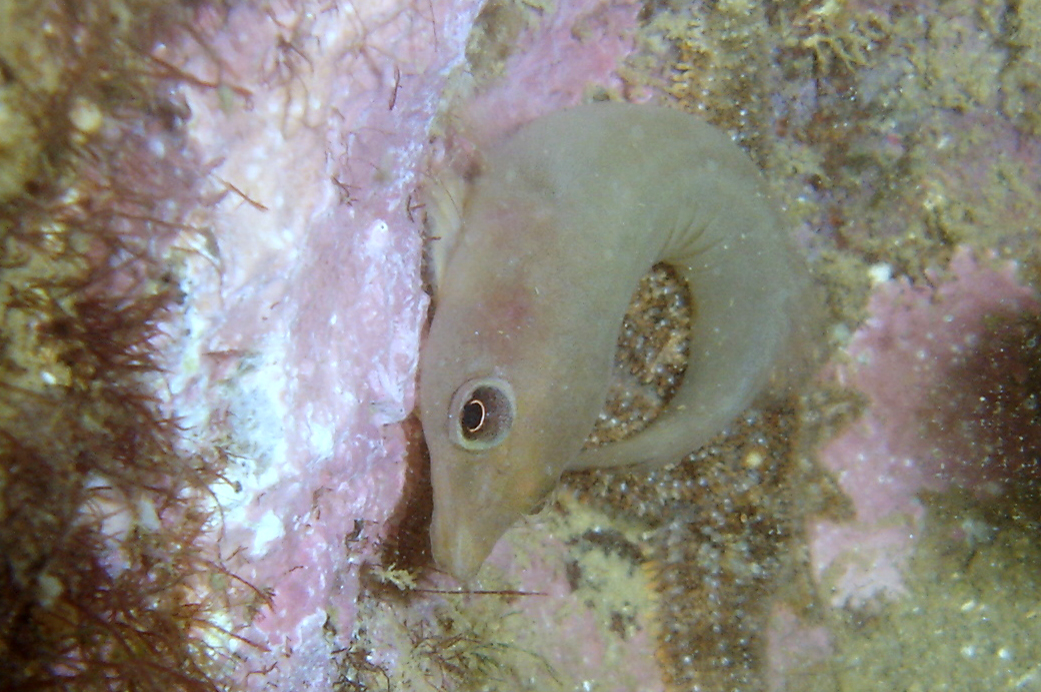- Classification
- ACTINOPTERYGII
- PERCIFORMES
- GOBIESOCIDAE
- Aspasmogaster
- liorhynchus
Smoothsnout Clingfish, Aspasmogaster liorhynchus Briggs 1955
Other Names: Smooth-snout Clingfish

A Smoothsnout Clingfish, Aspasmogaster liorhynchus, at Ricketts Point, Port Phillip, Victoria, 24 March 2009. Source: Sarah Speight / Flickr. License: CC by Attribution-NonCommercial-ShareAlike
Summary:
A pale greenish-brown, pale brown or dusky-brown clingfish, usually with many very small dark spots, some of which may join together to form short irregular lines.
Cite this page as:
Bray, D.J. 2025, Aspasmogaster liorhynchus in Fishes of Australia, accessed 27 Jun 2025, https://fishesofaustralia.net.au/home/species/1148
Smoothsnout Clingfish, Aspasmogaster liorhynchus Briggs 1955
More Info
|
Distribution |
Sydney, New South Wales, to the Recherche Archipelago, Western Australia, including northern Tasmania. Inhabits coastal rocky reefs in shallow subtidal and intertidal areas, often sheltering in ledges with sea urchins; also found near jetties.Occurs in shallow coastal reefs, usually in ledges with sea urchins |
|
Features |
Dorsal fin 6-8; Anal fin 6-7; Pectoral fin 20-23; Caudal fin 10-12; Vertebrae 32. Body moderately robust, depressed anteriorly, compressed posteriorly; caudal peduncle very short. Head moderately wide, flattened, tapering to rather pointed snout; eyes of moderate size; lips moderately narrow, lower lip with obvious skinfold anteriorly on each side; snout smooth, without prominent transverse skinfold; mouth moderately small, reaching to below front of eyes, lower jaw barely shorter than upper; teeth small, conical; no spines laterally on head; gill openings large, lateral. Scales and lateral line absent; some sensory papillae on sides. Single moderately short dorsal fin immediately before, but not connected with caudal fin; anal fin slightly smaller than and below dorsal, neither fin with anterior rays swollen at base; caudal fin rounded. Pectoral fins rounded, no fleshy pad ventrally on their bases. Pelvic fins united into ventral sucking disc of moderate size, consisting of anterior and posterior halves. |
|
Etymology |
The specific name is from the Greek leios (= smooth) and rhynchos (= snout), in reference to the lack of an accessory fold of tissue across the tip of the snout, the region behind premaxillary groove being smooth. |
|
Species Citation |
Aspasmogaster liorhynchus Briggs 1955, Stanford Ichthyological Bulletin 6: 51. Type locality: Coogee, near Sydney, New South Wales. |
|
Author |
Bray, D.J. 2025 |
|
Resources |
Smoothsnout Clingfish, Aspasmogaster liorhynchus Briggs 1955
References
Briggs, J.C. 1955. A monograph of the clingfishes (order Xenopterygii). Stanford Ichthyological Bulletin 6: 1-224 figs 1-114
Hutchins, J.B. 1984. Description of a new gobiesocid fish from south-western Australia, with a key to the species of Aspasmogaster. Records of the Western Australian Museum 11(2): 129-140 figs 1-5
Hutchins, J.B. 1994. Family Gobiesocidae. pp. 305-324, figs 269-289 in Gomon, M.F., Glover, C.J.M. & Kuiter, R.H. (eds). The Fishes of Australia's South Coast. Adelaide : State Printer 992 pp. 810 figs.
Hutchins, J.B. 2008. Family Gobiesocidae. pp. 722-741 in Gomon, M.F., Bray, D.J. & Kuiter, R.H. (eds). Fishes of Australia's Southern Coast. Sydney : Reed New Holland 928 pp. (as Aspasmogaster liorhyncha)
Kuiter, R.H. 1993. Coastal fishes of south-eastern Australia. Bathurst : Crawford House Press 437 pp.




